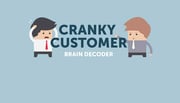The Keys to Account Retention
in Key Account Management /There’s been some conversation about factors that influence account retention. A recent post on LinkedIn by Greg Daines cited research that smaller customers have less than half the average lifespan of Midmarket (MM) and Enterprise (ENT) customers. They also noted that the best predictor of customer retention is measurable customer results.
Neither of these things come as a surprise. We’ve always believed that you should focus your efforts on the 20% of your base that generates 80% of your business and that delivering value to your customers is essential for retention.
But these things don’t happen on their own. It starts by selecting the right key accounts and then following a structured, repeatable process to help these accounts receive measurable value from using your product or service.
Selecting the Right Key Accounts
Retaining top accounts starts with the process you use to identify your key accounts. These are the top accounts generating up to 80% of your company’s revenue. You should invest additional resources on these customers, so they receive the maximum value from your product or service.
Since you don’t have unlimited resources, it’s important to choose wisely and revisit your selections on a routine basis as situations evolve over time. We recommend that you start the key account selection process by choosing 3-5 attributes to help you identify these top-tier accounts.
Some criteria you might use during your selection process include:
- Product fit – Key accounts should match your ideal customer profile and be able to use your product to meet their goals in the long term
- Existing relationships – The strength of the key account relationship should have the potential to go beyond vendor status for steady growth. So, customers resistant to this type of relationship may be a poor fit.
- Geographic alignment – This element is important if account geography influences a KAM’s ability to service and grow their accounts. For example, working across multiple time zones may be a deterrent.
- Revenue potential – Selecting key accounts doesn’t mean choosing accounts based on their size. For example, an account that is already generating its greatest revenue may require less assistance in maintaining the value they receive from your product. Whereas a mid-sized business with excellent growth and expansion potential may be a prime candidate for key account status. This is where your KAMs can have the greatest impact on customer goals while delivering the greatest revenue growth.
- Solvency – The financial stability of your top-tier accounts is an important consideration so you don’t waste valuable resources on a business lacking long-term potential.
- ARR – Another way to financially evaluate potential key accounts is by looking at their current annual recurring revenue (ARR). This helps you discern the growth potential and profitability of an account.
- Shared vision – Select customers with needs, goals, and strategies aligned with yours so your KAMs can easily engage with their top-tier accounts and develop more fruitful partnerships.
Now that you’ve created a key accounts list, it’s time for your key account managers (KAMs) to get to work delivering value to these VIP accounts.
A Structured, Repeatable Process to Deliver Value
Help your KAMs be as efficient and productive as possible so they can not only retain these top accounts but also help them grow. This may seem easier said than done, but it isn’t that difficult when you arm your KAM team with a structured, repeatable process like our KAM process.
The KAM process consists of three main repeatable steps:
- Know – This step helps you develop a deeper understanding of the customer and their goals. Activities used to glean this information include mapping out org charts, conducting Voice of Customer (VOC) interviews, and completing SWOT analyses. This arms you with insights to help drive more value for each customer.
- Act – This part of the process involves strategic thinking around what was learned during the Know phase to create an action plan to help the customer achieve their desired results or objectives.
- Measure – Once you have gotten to know your customer more deeply and created a plan of action, you need to track measurements to gauge your progress toward goal attainment. It’s important to use key measurements that are meaningful to the customer and report back to them routinely. This is a great way to remind customers of the value being delivered.
Once all steps have been completed, it’s time to revisit each step again to keep current and adjust as the customer and the marketplace evolve.
This process gives KAMs an easy-to-follow roadmap that takes all the guesswork out of what to do and when. As a result, KAMs don’t waste time trying to figure out what to do next as they advance through these steps.
This boosts efficiency, freeing up time for strategic efforts that make it easier to become trusted advisors in the eyes of their VIP accounts. Taking the relationship to this level facilitates attaining more mutually established goals and delivering more value to these customers.
Increase Your Company’s Customer Retention
Retaining customers is essential to the longevity of your business. Boost customer retention by carefully selecting the key accounts worthy of the additional resources of your KAM team. Then implement a structured repeatable KAM process to increase customer engagement, reduce churn, and boost revenue.
Want to learn more about the KAM process and how to increase customer retention? Register for KAMCon at early bird rates through February 28th.







